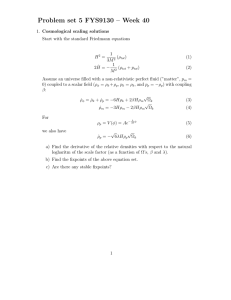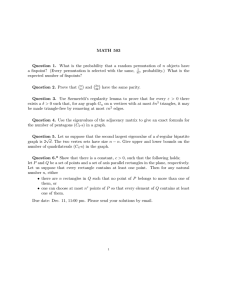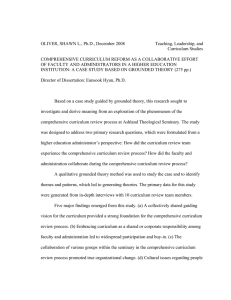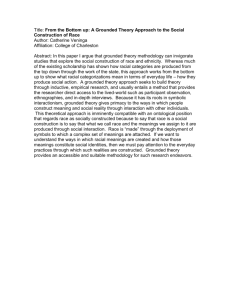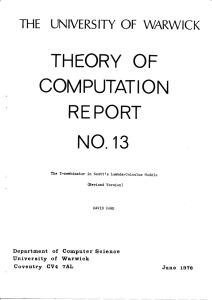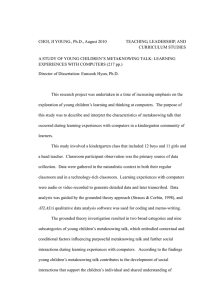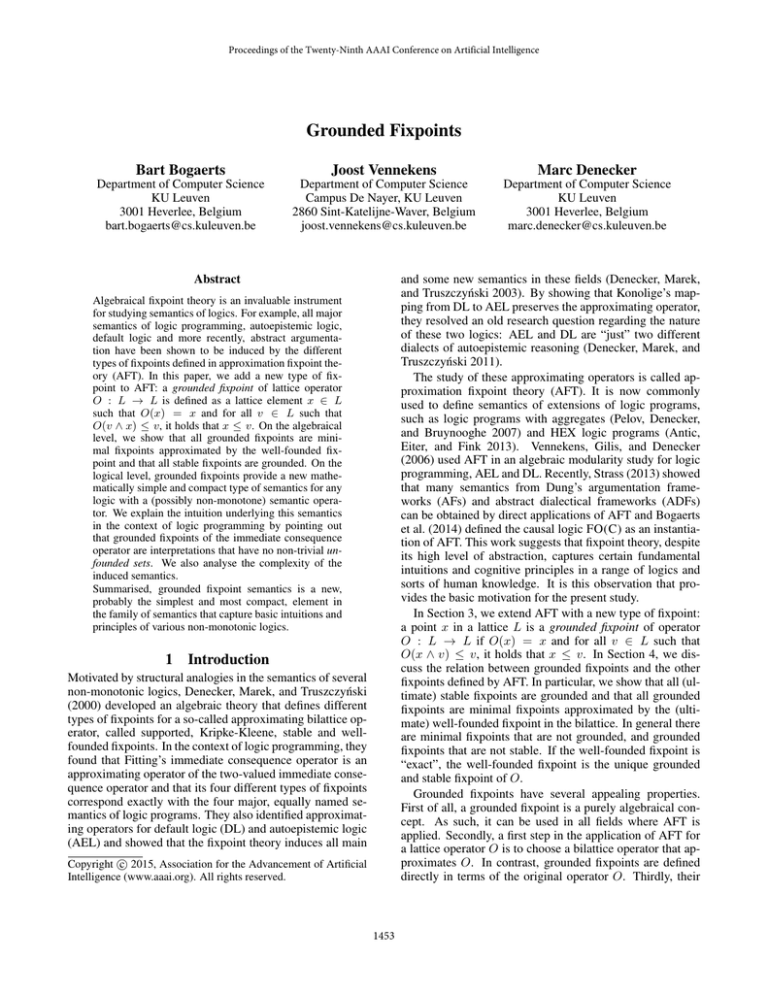
Proceedings of the Twenty-Ninth AAAI Conference on Artificial Intelligence
Grounded Fixpoints
Bart Bogaerts
Joost Vennekens
Marc Denecker
Department of Computer Science
KU Leuven
3001 Heverlee, Belgium
bart.bogaerts@cs.kuleuven.be
Department of Computer Science
Campus De Nayer, KU Leuven
2860 Sint-Katelijne-Waver, Belgium
joost.vennekens@cs.kuleuven.be
Department of Computer Science
KU Leuven
3001 Heverlee, Belgium
marc.denecker@cs.kuleuven.be
Abstract
and some new semantics in these fields (Denecker, Marek,
and Truszczyński 2003). By showing that Konolige’s mapping from DL to AEL preserves the approximating operator,
they resolved an old research question regarding the nature
of these two logics: AEL and DL are “just” two different
dialects of autoepistemic reasoning (Denecker, Marek, and
Truszczyński 2011).
The study of these approximating operators is called approximation fixpoint theory (AFT). It is now commonly
used to define semantics of extensions of logic programs,
such as logic programs with aggregates (Pelov, Denecker,
and Bruynooghe 2007) and HEX logic programs (Antic,
Eiter, and Fink 2013). Vennekens, Gilis, and Denecker
(2006) used AFT in an algebraic modularity study for logic
programming, AEL and DL. Recently, Strass (2013) showed
that many semantics from Dung’s argumentation frameworks (AFs) and abstract dialectical frameworks (ADFs)
can be obtained by direct applications of AFT and Bogaerts
et al. (2014) defined the causal logic FO(C) as an instantiation of AFT. This work suggests that fixpoint theory, despite
its high level of abstraction, captures certain fundamental
intuitions and cognitive principles in a range of logics and
sorts of human knowledge. It is this observation that provides the basic motivation for the present study.
In Section 3, we extend AFT with a new type of fixpoint:
a point x in a lattice L is a grounded fixpoint of operator
O : L → L if O(x) = x and for all v ∈ L such that
O(x ∧ v) ≤ v, it holds that x ≤ v. In Section 4, we discuss the relation between grounded fixpoints and the other
fixpoints defined by AFT. In particular, we show that all (ultimate) stable fixpoints are grounded and that all grounded
fixpoints are minimal fixpoints approximated by the (ultimate) well-founded fixpoint in the bilattice. In general there
are minimal fixpoints that are not grounded, and grounded
fixpoints that are not stable. If the well-founded fixpoint is
“exact”, the well-founded fixpoint is the unique grounded
and stable fixpoint of O.
Grounded fixpoints have several appealing properties.
First of all, a grounded fixpoint is a purely algebraical concept. As such, it can be used in all fields where AFT is
applied. Secondly, a first step in the application of AFT for
a lattice operator O is to choose a bilattice operator that approximates O. In contrast, grounded fixpoints are defined
directly in terms of the original operator O. Thirdly, their
Algebraical fixpoint theory is an invaluable instrument
for studying semantics of logics. For example, all major
semantics of logic programming, autoepistemic logic,
default logic and more recently, abstract argumentation have been shown to be induced by the different
types of fixpoints defined in approximation fixpoint theory (AFT). In this paper, we add a new type of fixpoint to AFT: a grounded fixpoint of lattice operator
O : L → L is defined as a lattice element x ∈ L
such that O(x) = x and for all v ∈ L such that
O(v ∧ x) ≤ v, it holds that x ≤ v. On the algebraical
level, we show that all grounded fixpoints are minimal fixpoints approximated by the well-founded fixpoint and that all stable fixpoints are grounded. On the
logical level, grounded fixpoints provide a new mathematically simple and compact type of semantics for any
logic with a (possibly non-monotone) semantic operator. We explain the intuition underlying this semantics
in the context of logic programming by pointing out
that grounded fixpoints of the immediate consequence
operator are interpretations that have no non-trivial unfounded sets. We also analyse the complexity of the
induced semantics.
Summarised, grounded fixpoint semantics is a new,
probably the simplest and most compact, element in
the family of semantics that capture basic intuitions and
principles of various non-monotonic logics.
1
Introduction
Motivated by structural analogies in the semantics of several
non-monotonic logics, Denecker, Marek, and Truszczyński
(2000) developed an algebraic theory that defines different
types of fixpoints for a so-called approximating bilattice operator, called supported, Kripke-Kleene, stable and wellfounded fixpoints. In the context of logic programming, they
found that Fitting’s immediate consequence operator is an
approximating operator of the two-valued immediate consequence operator and that its four different types of fixpoints
correspond exactly with the four major, equally named semantics of logic programs. They also identified approximating operators for default logic (DL) and autoepistemic logic
(AEL) and showed that the fixpoint theory induces all main
c 2015, Association for the Advancement of Artificial
Copyright Intelligence (www.aaai.org). All rights reserved.
1453
We call hL, ≤i a complete lattice if every subset of L has a
least upper bound and a greatest lower bound. A complete
lattice has both a least element ⊥ and a greatest element >.
An operator O : L → L is monotone if x ≤ y implies
that O(x) ≤ O(y). An element x ∈ L is a prefixpoint, a
fixpoint, a postfixpoint if O(x) ≤ x, respectively O(x) =
x, x ≤ O(x). Every monotone operator O in a complete
lattice has a least fixpoint, denoted lfp(O), which is also O’s
least prefixpoint and the limit (the least upper bound) of the
increasing sequence (xi )i≥0 defined by
• x0 = ⊥,
• xi+1 = O(xi ),
• xλ = lub({xi | i < λ}), for limit ordinals λ.
definition formalises and generalises well-known intuitions.
In the context of logic programming, which we discuss
in Section 5, the algebraic results show that grounded fixpoints induce a semantics that is slightly more “liberal” than
stable semantics: all stable models are grounded (i.e., we
identified a property all stable models have in common)
but also every grounded fixpoint is approximated by the
well-founded model; the differences collapse in case the
well-founded model is two-valued. We will see that for
logic programming, this semantics is simple and intuitive:
we show that the grounded fixpoints can be characterised
in terms of a generalised notion of unfounded set. Contrary to the more common semantics of logic programs,
grounded fixpoint semantics does not rely on any form of
three-valued logic: It is defined directly in terms of the (twovalued!) immediate consequence operator. The grounded
fixpoint semantics is very flexible towards language extensions. Currently, much research is being conducted in order to extend stable and well-founded semantics for logic
programs with new language constructs (Pelov, Denecker,
and Bruynooghe 2007; Faber, Pfeifer, and Leone 2011;
Marek, Niemelä, and Truszczyński 2008; Balduccini 2013).
Since the grounded fixpoint semantics is completely defined
using the two-valued immediate consequence operator, it
suffices to extend this operator to obtain an extended semantics; this is often trivial. These nice properties come at a
cost: we show that in general, determining whether a logic
program has a grounded fixpoint is ΣP
2 -complete. However,
for large classes of programs, grounded fixpoint semantics
coincides with stable semantics. For those programs, we obtained a simple, concise, purely 2-valued and algebraical,
extensible reformulation of the existing semantics.
Due to space limitations, we do not elaborate on how our
theory applies to AEL, DL or ADFs and refer to (Bogaerts,
Vennekens, and Denecker 2014) for proofs.
Summarised, the main contributions of this paper are as
follows. We extend AFT with the notion of a grounded
fixpoint, a fixpoint closely related to stable fixpoints with
similar properties, but that is determined by O, not by the
choice of an approximator. Applied to logic programming
this yields an intuitive, purely two-valued, semantics that is
easily extensible and that formalises well-known intuitions.
2
2.1
2.2
Logic Programming
In the following sections, we illustrate our abstract results
in the context of logic programming. We recall some preliminaries. We restrict ourselves to propositional logic
programs, but allow arbitrary propositional formulas in
rule bodies. However, AFT has been applied in a much
broader context (Denecker, Bruynooghe, and Vennekens
2012; Pelov, Denecker, and Bruynooghe 2007; Antic, Eiter,
and Fink 2013) and our results can also be applied in these
extensions of logic programming.
Let Σ be an alphabet, i.e., a collection of symbols which
are called atoms. A literal is an atom p or the negation ¬q of
an atom q. A logic program P is a set of rules r of the form
h ← ϕ, where h is an atom called the head of r, denoted
head(r), and ϕ is a propositional formula called the body of
r, denoted body(r). An interpretation I of the alphabet Σ is
an element of 2Σ , i.e., a subset of Σ. The set of interpretations 2Σ forms a lattice equipped with the order ⊆. The truth
value (t or f ) of a propositional formula ϕ in a structure I,
denoted ϕI is defined as usual. With a logic program P, we
associate an immediate consequence operator (van Emden
and Kowalski 1976) TP that maps a structure I to
TP (I) = {p | ∃r ∈ P : head(r) = p ∧ body(r)I = t}.
3
Grounded Fixpoints
Let hL, ≤i be a complete lattice and O : L → L a lattice
operator, fixed throughout this entire section. We start by
giving the most central definition of this text, namely the
notion of groundedness.
Definition 3.1 (Grounded). We call x ∈ L grounded for
O if for each v ∈ L such that O(v ∧ x) ≤ v, it holds that
x ≤ v.
The intuition behind this concept is easiest to explain if
we assume that the elements of L are sets of “facts” of some
kind and the ≤ relation is the subset relation between such
sets. In this case, a point x is grounded if it contains only
facts that are sanctioned by the operator O, in the sense that
if we remove them from x, then the operator will add at least
one of them again. The above definition captures this idea,
by using a set v ∈ L to remove all elements not in v from x.
If their removal is not contradicted by O, i.e., O does not
re-derive any removed element (O(x ∧ v) ≤ v), then these
elements cannot be part of the grounded point (x ≤ v).
Preliminaries
Lattices and Operators
A poset hL, ≤i is a set L equipped with a partial order ≤,
i.e., a reflexive antisymmetric, transitive relation. If S is a
subset of L, then x is an upper bound, respectively a lower
bound of S if for every s ∈ S, it holds that s ≤ x respectively x ≤ s. An element x is a least upper bound, respectively greatest lower bound of S if it is an upper bound that is
smaller than every other upper bound, respectively a lower
bound that is greater than every other lower bound. If S
has a least upper bound, respectively a greatest lower bound,
we denote it lub(S), respectively glb(S). As is custom, we
sometimes call a greatest lower bound a meet,Vand a least upper bound a join and use
W the related notations S = glb(S),
x∧y = glb({x, y}), S = lub(S) and x∨y = lub({x, y}).
1454
denote the set of consistent elements. Elements (x, x) ∈ Lc
are called exact. We sometimes abuse notation and use the
tuple (x, y) and the interval [x, y] interchangeably. The precision ordering on L2 is defined as (x, y) ≤p (u, v) if x ≤ u
and v ≤ y. In case (u, v) is consistent, this means that
(x, y) approximates all elements approximated by (u, v), or
in other words that [u, v] ⊆ [x, y]. If L is a complete lattice,
then hL2 , ≤p i is also a complete lattice.
AFT studies fixpoints of lattice operators O : L → L
through operators approximating O. An operator A : L2 →
L2 is an approximator of O if it is ≤p -monotone, and has
the property that for all x, O(x) ∈ A(x, x). Approximators
are internal in Lc (i.e., map Lc into Lc ). As usual, we restrict
our attention to symmetric approximators: approximators A
such that for all x and y, A(x, y)1 = A(y, x)2 . Denecker,
Marek, and Truszczyński (2004) showed that the consistent
fixpoints of interest (supported, stable, well-founded) are
uniquely determined by an approximator’s restriction to Lc ,
hence, sometimes we only define approximators on Lc .
AFT studies fixpoints of O using fixpoints of A. The AKripke-Kleene fixpoint is the ≤p -least fixpoint of A and has
the property that it approximates all fixpoints of O. A partial
A-stable fixpoint is a pair (x, y) such that x = lfp(A(·, y)1 )
and y = lfp(A(x, ·)2 ), where A(·, y)1 denotes the operator L → L : x 7→ A(x, y)1 and analogously for A(x, ·)2 .
The A-well-founded fixpoint is the least precise partial Astable fixpoint. An A-stable fixpoint of O is a fixpoint x
of O such that (x, x) is a partial A-stable fixpoint. This is
equivalent with the condition that x = lfp(A(·, x)1 ). The
A-Kripke-Kleene fixpoint of O can be constructed by iteratively applying A, starting from (⊥, >). For the A-wellfounded fixpoint, a similar constructive characterisation has
been worked out by Denecker and Vennekens (2007).
In general, a lattice operator O : L → L has a family of
approximators of different precision. Denecker, Marek, and
Truszczyński (2004) showed that there exists a most precise
approximator, UO , called the ultimate approximator of O.
c
c
This
V operatorWis defined by UO : L → L : (x, y) 7→
( O([x, y]), O([x, y])). Semantics defined using the ultimate approximator have as advantage that they only depend on O since the approximator can be derived from O.
It was shown that for any approximator A, all A-stable fixpoints are UO -stable fixpoints, and the UO -well-founded fixpoint is always more precise than the A-well-founded fixpoint. We refer to UO -stable fixpoints as ultimate stable
fixpoints of O and to the UO -well-founded fixpoint as the
ultimate well-founded fixpoint of O.
Proposition 3.2. If O is a monotone operator and x is
grounded for O then x is a postfixpoint of O that is less than
or equal to lfp(O), i.e., x ≤ O(x) and x ≤ lfp(O).
Example 3.3. The converse of Proposition 3.2 does not
hold. Consider the following logic program P:
(
)
p.
q ← p ∨ q.
Its immediate consequence operator TP is represented by
the following graph, where full edges express the order relation (to be precise, the ≤ relation is the reflexive transitive
closure of these edges) and the dotted edges represent the
operator:
q}
5 >6 = {p,
W hPPPi
PPP
nnn
n
n
PP
nnn
{p} hQQ
6 {q}
c QQQ
mmm
m
QQQ
m
mmm
⊥=∅
TP is a monotone operator with least fixpoint >. Also, {q}
is a postfixpoint of TP since TP ({q}) = > ≥ {q}. However, {q} is not grounded since TP ({q} ∧ {p}) = TP (⊥) =
{p} ≤ {p}, while {q} 6≤ {p}.
Proposition 3.4. All grounded fixpoints of O are minimal
fixpoints of O.
Example 3.5. The converse of Proposition 3.4 does not
hold. Consider the logic program P:
)
(
p ← p.
q ← ¬p ∨ q.
This logic program corresponds has as immediate consequence operator TP :
> = {p, q}
W hPPP
nn6
PPP
n
n
n
PP
n
+
s
nn
2 {q}
{p} hQQ
6
QQQ
mm
QQQ
mmm
mmm
⊥=∅
In this case, {p} is a minimal fixpoint of TP , but {p} is not
grounded since TP ({p} ∧ {q}) = TP (⊥) = {q}.
Proposition 3.6. A monotone operator has exactly one
grounded fixpoint, namely its least fixpoint.
4
4.1
AFT and Logic Programming In the context of logic
2
programming, elements of the bilattice 2Σ are partial interpretations, pairs I = (I1 , I2 ) of interpretations. The pair
(I1 , I2 ) approximates all interpretations I 0 with I1 ⊆ I 0 ⊆
I2 . We are mostly concerned with consistent (or, threevalued) interpretations: tuples I = (I1 , I2 ) with I1 ⊆ I2 .
For such an interpretation, the atoms in I1 are true (t) in I,
the atoms in I2 \I1 are unknown (u) in I and the other atoms
are false (f ) in I. If I is a three-valued interpretation, and ϕ
a formula, we write ϕI for the standard three-valued valuation based on the Kleene truth tables (Kleene 1938). An in-
Grounded Fixpoints and AFT
Preliminaries: AFT
Given a lattice L, approximation fixpoint theory makes uses
of the bilattice L2 . We define two projection functions
for pairs as usual: (x, y)1 = x and (x, y)2 = y. Pairs
(x, y) ∈ L2 are used to approximate all elements in the interval [x, y] = {z | x ≤ z ∧ z ≤ y}. We call (x, y) ∈ L2 consistent if x ≤ y, that is, if [x, y] is non-empty. We use Lc to
1455
terpretation I corresponds to the partial interpretation (I, I).
If I = (I1 , I2 ) is a (partial) interpretation, and U ⊆ Σ, we
write I[U : f ] for the (partial) interpretation that equals I on
all elements not in U and that interprets all elements in U as
f , i.e., the interpretation (I1 \ U, I2 \ U ).
Several approximators have been defined for logic programs. The most common is Fitting’s immediate consequence operator ΨP (Fitting 2002), a direct generalisation
of TP to partial interpretations. Denecker, Marek, and
Truszczyński (2000) showed that the well-founded fixpoint
of ΨP is the well-founded model of P (Van Gelder, Ross,
and Schlipf 1991) and that ΨP -stable fixpoints are exactly
the stable models of P (Gelfond and Lifschitz 1988).
Contrary to classical stable and well-founded semantics,
their ultimate counterparts have the nice property that they
are insensitive to equivalence preserving rewritings of the
bodies of rules. If two logic programs P and P 0 have the
same immediate consequence operator, then their ultimate
stable (respectively ultimate well-founded) models are the
same. For example consider programs P = {p ← p ∨ ¬p}
and P 0 = {p.}. Even though the body of the rule defining p in P is a tautology, {p} is not a stable model of P
(while it is a stable model of P 0 ). However, the ultimate stable semantics treats these two programs identically. However, this property comes at a cost. Denecker, Marek, and
Truszczyński (2004) showed that deciding whether P has
an ultimate stable model is Σ2P -complete, while that same
task is only NP-complete for classical stable models.
4.2
Corollary 4.3. If A is an approximator of O, then all Astable fixpoints are grounded fixpoints of O.
Theorem 4.4. The well-founded fixpoint (u, v) of a symmetric approximator A of O approximates all grounded fixpoints of O.
Corollary 4.5. If the well-founded fixpoint of a symmetric
approximator A of O is exact, then this point is the unique
grounded fixpoint of O.
5
Grounded Fixpoints of Logic Programs
In this section, we discuss grounded fixpoints in the context of logic programming. It follows immediately from the
algebraical results (Corollary 4.3 and Theorem 4.4) that stable models are grounded fixpoints of the immediate consequence operator and that grounded fixpoints are minimal fixpoints approximated by the well-founded model. Grounded
fixpoints can be explained in terms of unfounded sets. Intuitively, an unfounded set is a set of atoms that might circularly support themselves, but have no support from outside.
Stated differently, an unfounded set of a logic program P
with respect to an interpretation I is a set U of atoms such
that P provides no support for the truth of any atom in U , except possibly support based on the truth of other atoms in U .
Since TP maps an interpretation I to the set of atoms supported by P in I, the above intuitions are directly formalised
as follows.
Definition 5.1 (2-Unfounded set). Let P be a logic program, TP the corresponding direct consequence operator
and I ∈ 2Σ an interpretation. A set U ⊆ Σ is a 2-unfounded
set of P with respect to I if TP (I[U : f ]) ∩ U = ∅.
Thus, U is a 2-unfounded set of P with respect to I if removing all elements of U from I results in a state I[U : f ]
where no atom in U is supported, i.e., TP (I[U : f ]) contains
no atoms from U . Definition 5.1 slightly differs from the
original definition of unfounded set by Van Gelder, Ross,
and Schlipf (1991) but it formalises the same intuitions. The
most important difference is that we work in a two-valued
setting, while van Gelder et al. defined unfounded sets in a
three-valued setting. For clarity, we refer to our unfounded
sets as “2-unfounded sets” and to the original definition as
“GRS-unfounded sets”. Our theory does not require any
form of three-valued logic. In Section 6, we extend our definition to a three-valued context and show that the different
notions of unfounded set are equivalent in the context of the
well-founded model construction.
Grounded Fixpoints and AFT
In this section, we discuss how groundedness relates to AFT.
More concretely, we show that all (ultimate) stable fixpoints
are grounded and that all grounded fixpoints are approximated by the (ultimate) well-founded fixpoint.
Proposition 4.1. All ultimate stable fixpoints of O are
grounded.
Example 4.2. The converse of Proposition 4.1 does not always hold. Consider the logic program P:
(
)
p ← ¬p ∨ q.
q ← ¬q ∨ p.
This logic program has as immediate consequence operator
TP :
> = {p, q}
O W hPPP
nn6
PPP
n
n
n
PP
n
nr n
{p} hQQ
m62 {q}
QQQ
mmm
QQQ
m
m
mm
⊥=∅
Example 5.2. Let P be the following program:
p ← q ∨ r.
q ← p.
t ← ¬s ∧ ¬r.
> is grounded for TP , since the only v with TP (> ∧ v) =
TP (v) ≤ v is > itself. However, since TPV
([⊥, >]) = L \
{⊥} and {p} ∧
V{q} = ⊥, it follows that (TP [⊥, >]) =
⊥. Thus, lfp( TP ([·, >])) = ⊥. Therefore, > is not an
ultimate stable fixpoint of TP .
Let I be the interpretation {p, q, s, t}. Then U1 = {p, q} is
an unfounded set of P with respect to I since I[U1 : f ] =
{s, t} and in this structure, the bodies of rules defining p and
q are false. More formally, TP (I[U1 : f ])∩U1 = ∅∩U1 = ∅.
U2 = {s, t} is not a 2-unfounded set of P with respect to
I since TP (I[U2 : f ]) ∩ U2 = {p, q, t} ∩ U2 = {t} 6= ∅.
The fact that all A-stable fixpoints are ultimate stable fixpoints (Denecker, Marek, and Truszczyński 2004) yields:
1456
In what follows, we use U c for the set complement of U ,
i.e., U c = Σ \ U .
Proposition 5.3. Let P be a logic program, TP the corresponding direct consequence operator and I ∈ 2Σ an interpretation. A set U ⊆ Σ is a 2-unfounded set of P with
respect to I if and only if TP (I ∧ U c ) ≤ U c .
Proposition 5.3 shows that U is a 2-unfounded set if and
only if its complement satisfies the condition on v in Definition 3.1! This allows us to reformulate the condition that I
is grounded as follows.
Proposition 5.4. A structure I is grounded for TP if and
only if I does not contain any atoms that belong to a 2unfounded set U of P with respect to I.
If I is a fixpoint of TP , then all sets U ⊆ I c are 2unfounded sets. We call these 2-unfounded sets trivial. With
this terminology, we find:
Corollary 5.5. A structure I is a grounded fixpoint of TP
if and only if it is a fixpoint of TP and P has no non-trivial
2-unfounded sets with respect to I.
Similarly to ultimate semantics, grounded fixpoints are insensitive to equivalence-preserving rewritings in the bodies
of rules: if P and P 0 are such that TP = TP 0 , then the
grounded fixpoints of P and P 0 coincide. Also similar to
ultimate semantics, the above property comes at a cost.
Theorem 5.6. The problem “given a finite propositional
logic program P, decide whether P has a grounded fixpoint” is ΣP
2 -complete.
Let us briefly compare grounded fixpoint semantics with
the two most frequently used semantics of logic programming: well-founded and stable semantics. Firstly, it deserves to be stressed that the three semantics provide different formalisations of a similar intuition: a certain minimality criterion for fixpoints (which we called groundedness).
Consequently it is to be expected that they often coincide.
We established that for programs with a two-valued wellfounded model, the three semantics coincide. This sort of
programs is common in applications for deductive databases
(Datalog and extensions (Abiteboul and Vianu 1991)) and
for representing inductive definitions (Denecker and Vennekens 2014). In contrast, well-founded semantics coincides
only seldom with stable semantics in the context of answer
set programming (ASP). We illustrated in Example 4.2 that
in this case, also stable and grounded fixpoint semantics may
disagree. This example is quite unwieldy, as are all such programs that we found. It led us to expect that for large classes
of ASP programs, both semantics still coincide. For those
programs, we have defined a an elegant, intuitive and concise reformulation of the existing semantics. It is a topic for
future research to search for characteristics of ASP programs
that guarantee that both semantics agree or disagree.
Grounded fixpoint semantics is, to the best of our knowledge, the first purely two-valued and algebraical semantics.
The well-founded semantics explicitly uses three-valued interpretations in the well-founded model construction. Stable
semantics uses three-valued logic implicitly: the GelfondLifschitz reduct corresponds to an evaluation in a partial interpretation. The ultimate versions of these semantics are
purely algebraical but still refer to three-valued interpretations (replacing Kleene valuation by supervaluation). Due to
this, ultimate stable and well-founded models are relatively
complex to understand.
Logic Programs with Abstract Constraint Atoms. The
fact that grounded fixpoints semantics is two-valued and algebraical makes it not only easier to understand, but also
to extend the semantics. To illustrate this, we consider
logic programs with abstract constraint atoms as defined by
Marek, Niemelä, and Truszczyński (2008). An abstract constraint is a collection C ⊆ 2Σ . A constraint atom is an
expression of the form C(X), where X ⊆ Σ and C is an abstract constraint. The goal of such an atom is to model constraints on subsets of X. The truth value of C(X) in interpretation I is t if I ∩ X ∈ C and f otherwise. Abstract constraints are a generalisation of pseudo-Boolean constraints,
cardinality constraints, and much more. A deterministic
logic program is a set of rules of the form1
p ← a1 ∧ · · · ∧ an ∧ ¬b1 ∧ · · · ∧ bm ,
where p is an atom and the ai and bi are constraint atoms.
The intuition behind such a rule is that p is justified if the
constraints ai are satisfied while the bi are not. This intuition
is captured in an extended immediate consequence operator:
TP (I) = {p | ∃r ∈ P : head(r) = p ∧ body(r)I = t}.
Grounded fixpoints of this operator still represent the same
intuitions: an interpretation I is grounded if it contains no
unfounded sets, or said differently, no atoms without external support. Thus, if it contains no set U of atoms such that
TP (I[U : f ]) ∩ U = ∅.
Example 5.7. Let Σ be the alphabet {a, b, c, d} For every i,
let C≥i be the cardinality constraint {X ⊆ Σ | |X| ≥ i}..
Consider the following logic program P over Σ:
a.
b ← C≥1 (Σ).
c ← ¬C≥4 (Σ). d ← C≥4 (Σ).
Any interpretation in which d holds is not grounded since
for every I, C≥4 (Σ)I[d:f ] = f and thus d 6∈ TP (I[d : f ]).
It can easily be verified that {a, b, c} is the only grounded
fixpoint of P.
This example illustrates that even for complex, abstract
extensions of logic programs, groundedness is an intuitive
property: for any extension, a point is grounded if it contains no self-supporting atoms. Also, it often possible to
derive common properties of all grounded fixpoints such as
the fact that d cannot be contained in any of them. Lastly,
groundedness easily extends to these rich formalisms (defining grounded fixpoints takes one line given the immediate
consequence operator). This is in sharp contrast with more
common semantics of logic programming (such as stable
1
Here, we limit ourselves to deterministic programs. In general,
Marek, Niemelä, and Truszczyński also described nondeterministic
programs. We come back to this issue in Section 6.
1457
GRS-unfounded sets (Lifschitz 2008). This again shows that
many of the intuitions used in Answer Set Programming are
also closely related to the notion of groundedness.
and well-founded semantics) which are often hard(er) to extend to richer formalisms, as can be observed by the many
different versions of those semantics that exist for logic programs with aggregates (Ferraris 2005; Son, Pontelli, and
Elkabani 2006; Pelov, Denecker, and Bruynooghe 2007;
Faber, Pfeifer, and Leone 2011; Gelfond and Zhang 2014).
6
Groundedness and Nondeterminism. In Section 5, we
restricted ourselves to logic programs with abstract constraint atoms in the bodies of rules. As argued by Marek,
Niemelä, and Truszczyński (2008), allowing them as well
in heads gives rise to a nondeterministic generalisation of
the immediate consequence operator. A consistent nondeterministic operator maps every point x ∈ L to a non-empty set
O(x) ⊆ L. The definition of groundedness can straightforwardly be extended to this nondeterministic setting: a point
x ∈ L is grounded for nondeterministic operator O, if x ≤ v
for all v such that O(x ∧ v) ≤ v, where we define for a set
X ⊆ L that X ≤ v if x ≤ v for every x ∈ X. A thorough
study of groundedness for nondeterministic operators is out
of the scope of this paper.
Discussion
Unfounded Sets. Unfounded sets were first defined by
Van Gelder, Ross, and Schlipf (1991) in their seminal paper introducing the well-founded semantics. Their definition
slightly differs from Definition 5.1.
Definition 6.1 (GRS-Unfounded set). Let P be a logic program and I a three-valued interpretation. A set U ⊆ Σ is a
GRS-unfounded set of P with respect to I, if for each rule r
with head(r) ∈ U , body(r)I = f or body(r)I[U :f ] = f .
The first difference between 2-unfounded sets and GRSunfounded sets is that GRS-unfounded sets are defined for
three-valued interpretations, while we restricted our attention to (total) interpretations. Our definition easily generalises to three-valued interpretations using Fitting’s operator:
Other Definitions of Groundedness. The terminology
“grounded” is heavily overloaded in the literature. This is
not a coincidence since this term often represents similar intuitions. For example Denecker, Marek, and Truszczyński
(2002) argued that ultimate stable models satisfy “some
groundedness condition” without defining this condition.
We formally defined groundedness and showed in Proposition 4.1 that with this definition, their claim indeed holds.
In 1988, Konolige defined notions of weak, moderate and
strong groundedness in order to formalise some of his intuitions regarding “good” models of autoepistemic theories.
However, as he mentions himself, the closest he got to formalising these intuitions was strong groundedness, a syntactical criterion that depends on how a theory is rewritten to a
normal form. We now claim2 that our notion of groundedness formalises his intuitions, or at least, that it works for all
examples he gave!
In Dung’s argumentation frameworks, the grounded semantics is also defined. Since this is defined as the least fixpoint of the (monotone) characteristic operator, in this case
this is the unique grounded fixpoint. However, Strass (2013)
showed that this does not generalise to abstract dialectical
frameworks, where the grounded extension corresponds to
the (ultimate) Kripke-Kleene fixpoint.
Definition 6.2 (3-Unfounded set). Let P be a logic program, ΨP Fitting’s immediate consequence operator and I
a three-valued interpretation. A set U ⊆ Σ is a 3-unfounded
set of P with respect to I if ΨP (I[U : f ])2 ∩ U = ∅.
This definition formalises the same intuitions as Definition 5.1: U is a 3-unfounded set if making all atoms in
U false results in a state where none of them can be derived. The following proposition relates the two notions of
unfounded sets.
Proposition 6.3. Let P be a logic program, I a three-valued
interpretation and U ⊆ Σ. The following hold.
• If U is a 3-unfounded set, then U is a GRS-unfounded set.
• If I[U : f ] is more precise than I, then U is a GRSunfounded set if and only if U is a 3-unfounded set.
We showed that for a certain class of interpretations, the
two notions of unfounded sets coincide. Furthermore, Van
Gelder et al. only use unfounded sets to define the wellfounded model construction. It follows immediately from
Lemma 3.4 in (Van Gelder, Ross, and Schlipf 1991) that
every partial interpretation I in that construction with GRSunfounded set U satisfies the condition in the second claim
in Proposition 6.3. This means that 3-unfounded sets and
GRS-unfounded sets are equivalent for all interpretations
that are relevant in the original work! Essentially, we provided a new formalisation of unfounded sets that correctly
formalises the underlying intuitions, and that coincides with
the old definition on all interpretations used in the original
work. Furthermore, our definition is simpler and translates
easily to algebra.
Corollary 5.5, which states that grounded fixpoints are fixpoints of TP that permit no non-trivial 2-unfounded sets,
might sound familiar. Indeed, it has been shown that an
interpretation is a stable model of a logic program if and
only if it is a fixpoint of TP and it permits no non-trivial
7
Conclusion
In this paper, we defined a new algebraical concept, namely
groundedness. We showed that grounded fixpoints behave
well with respect to other fixpoints studied in approximation
fixpoint theory: given an operator O and an approximator
A of O, all A-stable fixpoints are grounded for O and all
grounded fixpoints of O are approximated by the A-wellfounded fixpoint. Moreover, grounded fixpoints free us from
the need of choosing such an approximator: they are defined
directly in terms of the original lattice operator.
2
The journal version of this paper will formally describe the application of our theory to various fields, including a more detailed
discussion about the different notions of groundedness, Konolige’s
intuitions and the relation to grounded fixpoints.
1458
Denecker, M.; Marek, V. W.; and Truszczyński, M. 2003.
Uniform semantic treatment of default and autoepistemic
logics. Artif. Intell. 143(1):79–122.
Denecker, M.; Marek, V. W.; and Truszczyński, M. 2004.
Ultimate approximation and its application in nonmonotonic
knowledge representation systems. Information and Computation 192(1):84–121.
Denecker, M.; Marek, V. W.; and Truszczyński, M. 2011.
Reiter’s default logic is a logic of autoepistemic reasoning and a good one, too. In Brewka, G.; Marek, V.; and
Truszczyński, M., eds., Nonmonotonic Reasoning – Essays Celebrating Its 30th Anniversary. College Publications.
111–144.
Faber, W.; Pfeifer, G.; and Leone, N. 2011. Semantics and
complexity of recursive aggregates in answer set programming. Artif. Intell. 175(1):278–298.
Ferraris, P. 2005. Answer sets for propositional theories. In
Proceedings of International Conference on Logic Programming and Nonmonotonic Reasoning (LPNMR), 119–131.
Fitting, M. 2002. Fixpoint semantics for logic programming
a survey. Theoretical Computer Science 278(1-2):25–51.
Gelfond, M., and Lifschitz, V. 1988. The stable model semantics for logic programming. In Kowalski, R. A., and
Bowen, K. A., eds., ICLP/SLP, 1070–1080. MIT Press.
Gelfond, M., and Zhang, Y. 2014. Vicious circle principle
and logic programs with aggregates. TPLP 14(4-5):587–
601.
Kleene, S. C. 1938. On notation for ordinal numbers. The
Journal of Symbolic Logic 3(4):pp. 150–155.
Konolige, K. 1988. On the relation between default and
autoepistemic logic. Artif. Intell. 35:343–382.
Lifschitz, V. 2008. Twelve definitions of a stable model. In
Garcı́a de la Banda, M., and Pontelli, E., eds., ICLP, volume
5366 of LNCS, 37–51. Springer.
Marek, V. W.; Niemelä, I.; and Truszczyński, M. 2008.
Logic programs with monotone abstract constraint atoms.
TPLP 8(2):167–199.
Pelov, N.; Denecker, M.; and Bruynooghe, M. 2007. Wellfounded and stable semantics of logic programs with aggregates. TPLP 7(3):301–353.
Son, T. C.; Pontelli, E.; and Elkabani, I. 2006. An unfoldingbased semantics for logic programming with aggregates.
CoRR abs/cs/0605038.
Strass, H. 2013. Approximating operators and semantics for
abstract dialectical frameworks. Artif. Intell. 205:39–70.
van Emden, M. H., and Kowalski, R. A. 1976. The semantics of predicate logic as a programming language. J. ACM
23(4):733–742.
Van Gelder, A.; Ross, K. A.; and Schlipf, J. S. 1991. The
well-founded semantics for general logic programs. J. ACM
38(3):620–650.
Vennekens, J.; Gilis, D.; and Denecker, M. 2006. Splitting
an operator: Algebraic modularity results for logics with fixpoint semantics. ACM Trans. Comput. Log. 7(4):765–797.
Grounded fixpoint semantics is the first purely two-valued
and algebraical semantics for logic programming. Moreover, this semantics is compact, intuitive (directly based on
the notion of unfounded sets) and easily extensible: as long
as the (two-valued) immediate consequence operator is defined, the grounded fixpoint semantics is obtained for free.
Our theory can also be applied to AEL, DL, Dung’s argumentation frameworks and ADFs where it also results in a
semantics with attractive properties.2
Acknowledgements This work was supported by the KU
Leuven under project GOA 13/010 and by the Research
Foundation - Flanders (FWO-Vlaanderen).
References
Abiteboul, S., and Vianu, V. 1991. Datalog extensions
for database queries and updates. J. Comput. Syst. Sci.
43(1):62–124.
Antic, C.; Eiter, T.; and Fink, M. 2013. Hex semantics via
approximation fixpoint theory. In Cabalar, P., and Son, T. C.,
eds., LPNMR, volume 8148 of LNCS, 102–115. Springer.
Balduccini, M. 2013. ASP with non-herbrand partial functions: A language and system for practical use. TPLP 13(45):547–561.
Bogaerts, B.; Vennekens, J.; Denecker, M.; and Van den
Bussche, J. 2014. FO(C): A knowledge representation language of causality. TPLP 14(4-5-Online-Supplement):60–
69.
Bogaerts, B.; Vennekens, J.; and Denecker, M. 2014.
Grounded fixpoints. Technical Report CW 677, Departement of Computer Science, Katholieke Universiteit Leuven.
Denecker, M., and Vennekens, J. 2007. Well-founded semantics and the algebraic theory of non-monotone inductive
definitions. In Baral, C.; Brewka, G.; and Schlipf, J. S., eds.,
LPNMR, volume 4483 of LNCS, 84–96. Springer.
Denecker, M., and Vennekens, J. 2014. The well-founded
semantics is the principle of inductive definition, revisited.
In Baral, C.; De Giacomo, G.; and Eiter, T., eds., KR, 22–31.
AAAI Press.
Denecker, M.; Bruynooghe, M.; and Vennekens, J. 2012.
Approximation fixpoint theory and the semantics of logic
and answers set programs. In Erdem, E.; Lee, J.; Lierler,
Y.; and Pearce, D., eds., Correct Reasoning, volume 7265 of
LNCS. Springer. 178–194.
Denecker, M.; Marek, V.; and Truszczyński, M. 2000. Approximations, stable operators, well-founded fixpoints and
applications in nonmonotonic reasoning. In Minker, J.,
ed., Logic-Based Artificial Intelligence, volume 597 of The
Springer International Series in Engineering and Computer
Science. Springer US. 127–144.
Denecker, M.; Marek, V. W.; and Truszczyński, M. 2002.
Ultimate approximations in nonmonotonic knowledge representation systems. In Fensel, D.; Giunchiglia, F.; McGuinness, D. L.; and Williams, M.-A., eds., KR, 177–190. Morgan Kaufmann.
1459

